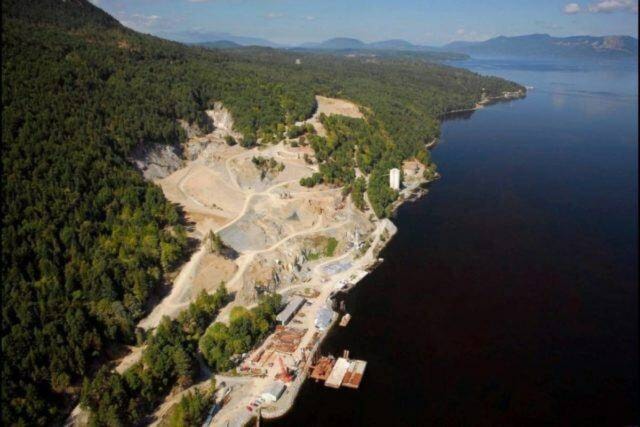The B.C. government has approved a permit for the Bamberton quarry expansion, but with a much smaller increase to its footprint and limitations on hours in which blasting is allowed.
Meanwhile, across the inlet, North Saanich council and Green Party MLA Adam Olsen are still urging the province to stall the expansion until a full environmental assessment is done.
“We have the B.C. Environmental Assessment Act, and that’s what it’s for,” North Saanich Coun. Celia Stock said at the district’s Jan. 29 council meeting.
The Malahat First Nation-owned quarry near Mill Bay will now only grow by 0.2 hectares, according to a government spokesperson who added that the planned increase in production will still go from 240,000 tonnes of rock per year to 479,000 tonnes.
Blasting will be limited to Monday through Friday between 9 a.m. and 5 p.m. with other operations allowed between 7 a.m. and 7 p.m. every day except Sundays.
The quarry’s size was originally to increase from 39.3 hectares to 45.7 hectares with operations ramping up to seven days per week.
George Heyman, B.C.’s minister of environment and climate change, decided last summer against requiring the quarry expansion to go through a full environmental assessment process and instead instructed that an “enhanced review” under the Mines Act be completed.
A press release from the ministry at the time said Heyman had considered the concerns of local residents and that he believed the enhanced review process would address them.
The Saanich Inlet Protection Society called for a full environment assessment, triggering a process that forced the minister to make a decision.
The Malahat First Nation had opposed the full environmental assessment of their project, saying at the time that the expansion was just an adjustment to an existing permit and project. Malahat administration did not respond to a request to comment for this story.
An enhanced review is less of a public process and Saanich Peninsula residents say they’re being left in the dark about the approval and the rationale behind it.
“We just have no information about it, and no one seems to be giving out any information,” Stock said in an interview on Feb. 6.
Olsen said that without a full environmental assessment, the process lacks transparency.
“As a result of that, there’s no way to hold the government accountable for what they’re doing,” he said.
The Protection Society’s Frances Pugh said her organization was aware the permit had been granted, but still called for the provincial government to do better at sharing information and involving Peninsula communities in the process.
“The lack of inclusion of other governments like the municipality of North Saanich, of Central Saanich, has been concerning,” Pugh said. “Just because it’s a body of water doesn’t mean it doesn’t affect what happens to our beaches, our community (and) the water column.”
The permit amendment was granted by the Ministry of Energy, Mines and Low-Carbon Innovation on Oct. 30, and the reasons behind the decision were included in documents posted on the ministry website.
But unlike when the decision not to conduct a full assessment was made by Heyman, no public announcement was made when the amended permit was issued.
As a result, the North Saanich council’s renewed calls for a full environmental assessment in a recent council meeting relied on information that didn’t include the revised size of the expansion.
The council passed a motion calling on the B.C. government to provide an update on this permit. The motion also had the goal of catching the attention of federal environmental officials by sending a resolution on the matter to the Association of Vancouver Island Coastal Communities’ upcoming April meetings.
Stock acknowledged that at this point in the process, it may be difficult to get the provincial government to fully reverse course.
“I know it’s kind of a long shot,” she said.
Olsen applauded North Saanich council’s work on bringing more attention to the issue, noting he still hears about it from many of his constituents.
As a member of the Tsartlip First Nation, he and his family have fished in the area for generations. The MLA for Saanich North and the Islands added the First Nation is holding an upcoming community meeting on the matter.
Olsen said the expansion of the quarry is indicative of the government’s approach to industrial activity in the inlet, and the continuing unrestrained excavation of the area.
“There doesn’t seem to be any end to grinding that mountain down,” he said.
When deciding to not proceed with a full environmental assessment, Heyman did commit to developing a process in conjunction with local First Nations to continually monitor the cumulative effects of industrial activity on the inlet.
READ MORE: Full environmental assessments nixed for 2 Bamberton projects



